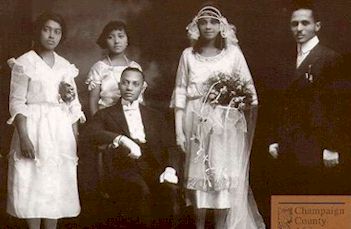|
Champaign County African American History Committee |
E-mail: |
Copyright © 1998 All rights reserved. |
Courtesy of: |

|
| SPRING 1997
|
|
| |
|
By Estelle Merrifield
I have been asked why I am a member of the Afro-American History Society of Champaign-Urbana. After much thought I realize that history, any history, has been a favorite hobby all of my life. I like to relate to people. There is much to be gained in remembering the past, and more to be gained by projecting into the future that which has been learned as it relates to the improvement of people. Technology changes but human nature has been the same since the beginning of time. Some of us arrived in this area around 1860 traveling by wagon, usually pulled by mules. One side of my family came from the eastern coast originating in and around Mt. Airey, North Carolina. The other side of my family came from the Smoky Mountains of Tennessee. Other families came from Tennessee, Mississippi, Georgia, Louisiana, Kentucky, and Arkansas. Most came escaping oppression and for economic reasons after the Civil War. Religion and faith were the threads that held our families together. Even until this day, religion and faith and family ties keep us together. Men were the head of the family, strong men. Women were the keepers of the home. The family Bible was, in most families, the recorder of family connections. Most of the early Negroes were former slaves. As slaves they had many talents. They were the builders of plantations, the workers of the fields, the makers of furniture, the woodchoppers, dressmakers, tailors. But as freedmen, when they arrived in the North, they found that these jobs were closed to them. They often worked as maids, farm hands, barbers, laborers, cooks, housekeepers, railroad gandy dancers, and a few ministers of the Gospel. It was not the land of opportunity they had been led to believe it was. They were still colored. Afro-American families settled in communities in and around Champaign County. Some settled near Broadlands, some near Newman, some in Tuscola, across the county line, some in Bellflower, some in or around Mansfield, Homer, Sidney, Ogden, Gibson City, Hoopston, Danville and Loda. Many of these families were related. When one family became established they would send for others to come north. Many of the relatives traveled on to Chicago and worked in steel mills, stock yards and as barbers, beauticians and laborers. We, as a historical group, are trying to establish a permanent record...something the children of our community can point to with pride and realize the dignity and resourcefulness that was a part of their heritage. When they look at the newly renamed streets of the Martin Luther King subdivision, when they see the Illinois Memorial Stadium, when they see the names of Holt, Phillips, Pope, Nelson, Foxwell, Dr. Ellis Edition, Wesley Park, Bridgewater Park, Lee, Britt, Rivers, Alexander, Jordan, Edwards - there is a reason for Champaign-Urbana honoring these family names. These are just a few of those who have contributed to our community. There are so many more persons and families, too numerous to describe at this time, who have contributed to the well being of the county of Champaign, the cities of Champaign-Urbana, the surrounding communities, the State of Illinois, and the United States of America. Why am I interested in Afro-American history? Any history?
Some of us may never make it into the 21st century, but we would like to be remembered as having prepared our children for the future by giving them a sense of security and stability. | |
| Back to the top of the page | |





